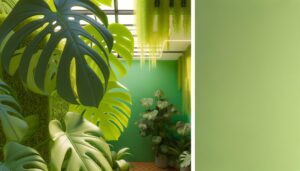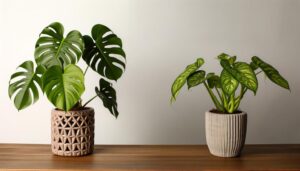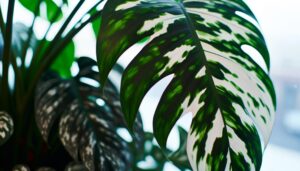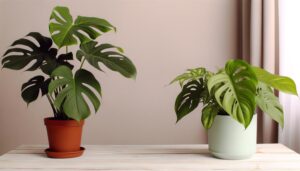Monstera Adansonii Trailing Vs Climbing
Understanding whether your Monstera adansonii should trail or climb hinges on its specific growth habits and aesthetic goals. Trailing typically results in smaller leaves with fewer fenestrations due to limited light exposure, while climbing encourages larger, more pronounced fenestrations and superior air circulation, minimizing fungal infections.
If you let your plant climb, you'll need vertical space for aerial roots and might consider moss poles or trellises for support. Trailing forms, requiring horizontal space, exude a lush, cascading effect.
They also need consistent moisture, high humidity, and bright indirect light. Grasping these distinctions will help you create an ideal environment for your plant's thriving.

Key Takeaways
- Climbing Monstera adansonii develops larger leaves with pronounced fenestrations, while trailing forms have smaller leaves with fewer fenestrations.
- Climbing variants need vertical space and support structures like moss poles, whereas trailing forms require ample horizontal space.
- Climbing promotes better air circulation and reduces fungal infections, enhancing overall plant health.
- Climbing Monstera adansonii offers a dramatic vertical aesthetic, while trailing provides a lush, cascading effect.
- Both forms thrive with bright, indirect light, consistent moisture, and high humidity levels for optimal growth.
Growth Habits
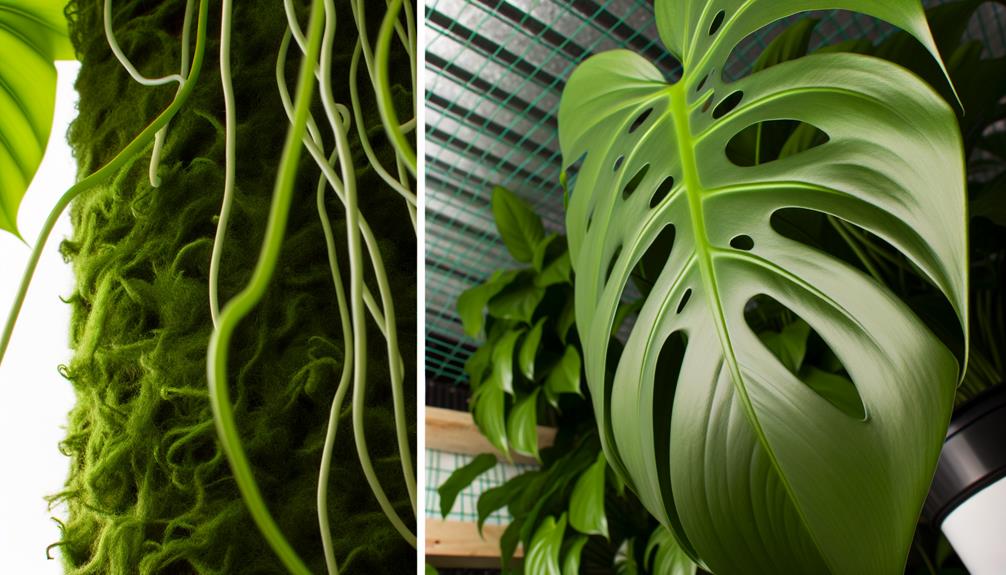
Monstera adansonii exhibits distinct growth habits depending on whether it's allowed to trail or climb, directly influencing its morphological characteristics and overall health.
If you let it trail, the plant tends to produce smaller leaves with fewer fenestrations due to limited access to light.
In contrast, when you provide a support structure for climbing, such as a moss pole, the plant exhibits more vigorous growth. You'll notice larger leaves with more pronounced fenestrations, as climbing mimics its natural epiphytic behavior.
Additionally, climbing promotes better air circulation around the leaves, reducing the likelihood of fungal infections.
Understanding these growth habits allows you to optimize conditions for your Monstera adansonii, achieving not only robust growth but also ensuring the plant's physiological requirements are met.
Aesthetic Appeal
Observing the aesthetic appeal of Monstera adansonii, whether trailing or climbing, reveals significant differences in leaf morphology and overall visual impact.
When trailing, the plant adopts a more pendulous form, with its fenestrated leaves cascading downwards, creating a dynamic, flowing appearance. The internodal spacing increases, giving a more elongated look.
Conversely, when climbing, the plant exhibits tighter node spacing, resulting in denser foliage. This growth form often enhances the visibility of the perforations in the leaves, presenting a more structured and orderly aesthetic. Additionally, climbing Monstera adansonii tends to produce larger leaves, contributing to a more dramatic display.
Each form invites a distinct visual experience, catering to different decor preferences and botanical aesthetics.
Space Requirements

Evaluating the space requirements for Monstera adansonii, whether trailing or climbing, requires an understanding of the plant's growth patterns and structural needs. When planning, consider the following:
- Vertical Growth: Climbing Monstera adansonii utilizes aerial roots to attach to supports, needing vertical space. Typically, it can reach heights of 6-8 feet indoors.
- Horizontal Spread: Trailing forms will cascade down from hanging baskets or shelves, needing ample horizontal space to avoid overcrowding.
- Pot Size: Both forms need appropriately sized containers to accommodate root growth, generally starting with a pot diameter of 6-8 inches.
- Support Structures: Climbing variants benefit from moss poles or trellises, requiring additional space for these supports.
Understanding these aspects ensures best growth conditions for your Monstera adansonii.
Care and Maintenance
To maximize growth and health, you must meticulously manage the watering schedule, humidity levels, and light conditions for your Monstera adansonii.
Ideal hydration involves providing consistent moisture without saturating the roots, which can lead to root rot. Employ a well-draining soil mix and optimize the pot with drainage holes.
Maintain ambient humidity at 60-80% to replicate its native tropical environment. Utilize a humidifier or pebble tray to achieve this.
Position the plant in bright, indirect light; direct sunlight can scorch its leaves, while insufficient light stunts growth.
Regularly monitor for pests like spider mites and mealybugs, and address infestations promptly with insecticidal soap or neem oil. Prune dead or yellowing leaves to promote vigorous development.
Supporting Structures

When supporting your Monstera Adansonii, you'll need to think about structures like trellises and moss poles to promote vertical growth.
Wall anchors and clips provide alternative methods for securing vines and encouraging a climbing habit.
Each option offers distinct benefits regarding stability, moisture retention, and aesthetic integration.
Trellises and Moss Poles
Trellises and moss poles provide essential structural support for Monstera Adansonii, guaranteeing ideal growth and health by mimicking the plant's natural climbing habitat. These tools offer stability and encourage vertical growth, which can greatly enhance leaf size and fenestration.
When choosing between trellises and moss poles, consider the following:
- Material Composition: Trellises are often made of wood or metal, while moss poles are constructed from sphagnum moss wrapped around a sturdy core.
- Moisture Retention: Moss poles retain moisture, promoting aerial root development, whereas trellises do not.
- Aesthetic Integration: Trellises can be more visually striking and customizable.
- Structural Strength: Metal trellises provide robust support for larger plants, whereas moss poles can degrade over time.
Understanding these factors guarantees your Monstera Adansonii thrives.
Wall Anchors and Clips
In addition to trellises and moss poles, wall anchors and clips offer alternative structural support, ensuring Monstera Adansonii can effectively climb and maintain ideal growth patterns.
Wall anchors, typically composed of durable plastic or metal, embed into wall surfaces, providing a strong anchor point.
Clips, often made from flexible materials, secure the plant's stems without causing harm, facilitating vertical growth.
For best results, strategically place anchors at regular intervals, allowing the Monstera's aerial roots to attach and stabilize. Employ clips to gently guide the plant towards these anchors, promoting even growth and preventing overcrowding.
This method not only maximizes vertical space but also enhances photosynthetic efficiency by exposing more foliage to light, fostering a healthier, more vibrant plant.
Common Challenges
When managing Monstera Adansonii, you'll face challenges like ensuring proper light conditions and mitigating pest and disease risks. Inadequate light can impede photosynthesis, leading to etiolation and stunted growth.
Additionally, infestations of spider mites or fungal infections can compromise plant health, necessitating vigilant monitoring and treatment.
Proper Light Conditions
Ensuring proper light conditions for Monstera adansonii involves understanding its preference for bright, indirect sunlight and mitigating the common challenges of insufficient or excessive light exposure. You need to recognize these critical factors:
- Light Intensity: Aim for 10,000 to 20,000 lux to mimic its natural habitat.
- Duration: Provide 12-14 hours of consistent light daily to sustain photosynthesis.
- Light Source: Utilize sheer curtains or filtered light to prevent direct sunlight, which can cause leaf scorch.
- Monitoring: Regularly assess leaf coloration; yellowing indicates excessive light, while dark green suggests insufficient light.
Pest and Disease Management
Managing pests and diseases in Monstera adansonii requires vigilance and a thorough understanding of common infestations like spider mites, mealybugs, and fungal infections. You need to regularly inspect your plant's foliage for signs of these pests, such as webbing or white cottony masses.
Spider mites thrive in dry conditions, so maintaining high humidity can deter them. Mealybugs can be eradicated with insecticidal soap or neem oil applications. Fungal infections, often caused by overwatering, manifest as brown spots or mold. To prevent this, ensure proper drainage and avoid excessive watering.
Implementing a quarantine protocol for new plants minimizes the risk of introducing pests. Regularly cleaning the leaves also helps in early detection and control of potential infestations.
Choosing the Best Method
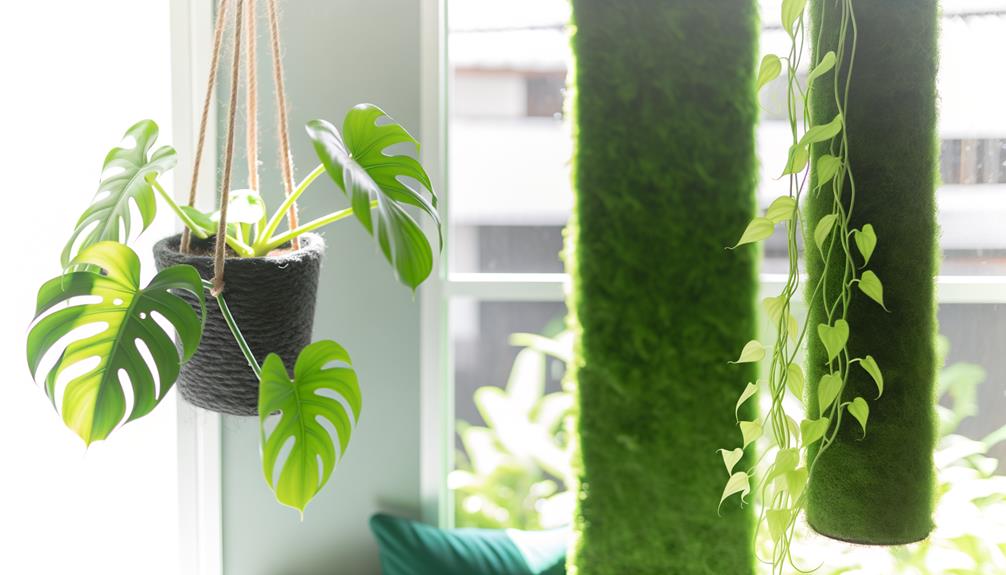
Selecting the best method for your Monstera Adansonii involves evaluating factors such as available space, light conditions, and desired aesthetic. Here's a detailed analysis to assist you:
- Space Constraints: In limited areas, trailing might suit better, as it allows the plant to cascade downwards without requiring vertical support.
- Light Conditions: Climbing provides uniform light exposure to leaves, optimizing photosynthesis. Trailing might result in shaded lower leaves.
- Aesthetic Goals: For a dramatic, vertical aesthetic, climbing is ideal. Trailing creates a lush, cascading effect.
- Growth Requirements: Climbing requires support structures like moss poles. Trailing needs frequent pruning to manage leggy growth.
Understanding these factors guarantees you'll cultivate a healthier, visually pleasing Monstera Adansonii tailored to your environment.
Conclusion
To wrap up, whether you choose to let your Monstera adansonii trail or climb, both methods offer unique advantages. Notably, studies show that climbing Monstera plants can grow up to three feet taller than their trailing counterparts.
Your decision should consider space constraints, aesthetic preferences, and the level of care you're willing to provide. By understanding these factors, you'll create a prime environment that showcases the natural beauty and vigor of your Monstera adansonii.

